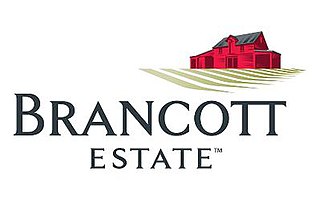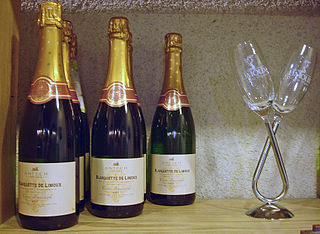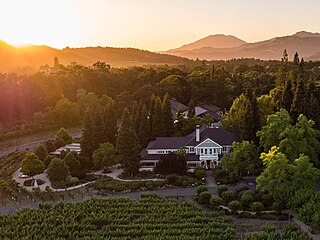Related Research Articles

Merlot is a dark blue–colored wine grape variety that is used as both a blending grape and for varietal wines. The name Merlot is thought to be a diminutive of merle, the French name for the blackbird, probably a reference to the color of the grape. Its softness and "fleshiness," combined with its earlier ripening, make Merlot a popular grape for blending with the sterner, later-ripening Cabernet Sauvignon, which tends to be higher in tannin.

Pinot noir, also known as Pinot nero, is a red-wine grape variety of the species Vitis vinifera. The name also refers to wines created predominantly from Pinot noir grapes. The name is derived from the French words for pine and black. The word pine alludes to the grape variety having tightly clustered, pinecone—shaped bunches of fruit.

A rosé is a type of wine that incorporates some of the color from the grape skins, but not enough to qualify it as a red wine. It may be the oldest known type of wine, as it is the most straightforward to make with the skin contact method. The pink color can range from a pale "onionskin" orange to a vivid near-purple, depending on the grape varieties used and winemaking techniques. Usually, the wine is labelled rosé in French, Portuguese, and English-speaking countries, rosado in Spanish, or rosato in Italian.

Franzia is a brand of wine produced by The Wine Group, known for its box wines sold in 3 and 5-liter cartons. Franzia wines, throughout their history, were known as affordable table wines, popular in the 1960s and 1970s as "jug wine", and now as "box wine". The Wine Group is the third largest wine company in the world, behind Constellation Brands and the E&J Gallo Winery. The Franzia brand today has no business relationship with Fred Franzia of the Bronco Wine Company, known for its low-cost Charles Shaw wines. The Franzia family sold the brand to Coca-Cola in 1973 when Fred Franzia was in his early adult years; and it was sold to The Wine Group in 1981.

French wine is produced throughout all of France in quantities between 50 and 60 million hectolitres per year, or 7–8 billion bottles. France is one of the largest wine producers in the world. French wine traces its history to the 6th century BCE, with many of France's regions dating their wine-making history to Roman times. The wines produced range from expensive wines sold internationally to modest wines usually only seen within France such as the Margnat wines of the post-war period.

New Zealand wine is produced in several of its distinct winegrowing regions. As an island country in the South Pacific Ocean, New Zealand has a largely maritime climate, although its elongated geography produces considerable regional variation from north to south. Like many other New World wines, New Zealand wine is usually produced and labelled as single varietal wines, or if blended, winemakers list the varietal components on the label. New Zealand is best known for its Marlborough Sauvignon Blanc, and more recently its dense, concentrated Pinot Noir from Marlborough, Martinborough and Central Otago.

Red Bicyclette is a French wine produced by the Sieur d'Arques cooperative and distributed in the United States by the E. & J. Gallo Winery. Its distinctive label appeals to consumers who prefer branded wines, labelled with the variety of grape from which they are made, rather than by the exact location. The following grape varieties are sold under the Red Bicyclette label: chardonnay, merlot, pinot noir, rosé and syrah.

Languedoc-Roussillon wine, including the vin de pays labeled Vin de Pays d'Oc, is produced in southern France. While "Languedoc" can refer to a specific historic region of France and Northern Catalonia, usage since the 20th century has primarily referred to the northern part of the Languedoc-Roussillon region of France, an area which spans the Mediterranean coastline from the French border with Spain to the region of Provence. The area has around 700,000 acres (2,800 km2) under vines and is the single biggest wine-producing region in the world, being responsible for more than a third of France's total wine production. In 2001, the region produced more wine than the United States.

Brancott Estate is the brand adopted since 2010 by Pernod Ricard for New Zealand's largest wine producer, formerly Montana Wines, which now operates as the New Zealand division of Pernod Ricard Winemakers. The name comes from its Brancott winery in Blenheim, and was chosen to reduce confusion in the United States market with wines from the state of Montana.
The state of Oregon in the United States has established an international reputation for its production of wine, ranking fourth in the country behind California, Washington, and New York. Oregon has several different growing regions within the state's borders that are well-suited to the cultivation of grapes; additional regions straddle the border between Oregon and the states of Washington and Idaho. Wine making dates back to pioneer times in the 1840s, with commercial production beginning in the 1960s.

Bien Nacido Vineyards is cool-climate vineyard on the central coast of California. Located midway up the Santa Maria Valley, it is known for growing Burgundian and Rhone varieties of wine grapes. Bien Nacido has the distinction of being one of the major viticultural nurseries in the state for certified, varietal budwood. Most of the vines were originally from stock grown by the University of California at Davis. While the average increase block in California is less than 10 acres (40,000 m2), Bien Nacido Vineyards has several hundred acres of certified Chardonnay, Pinot Noir, Merlot and a number of other varieties. Much of the Chardonnay planted in California in the last twenty years began as Bien Nacido Vineyards cuttings.
Arbor Mist is the brand name of an alcoholic beverage which blends wines such as Merlot, Zinfandel and Chardonnay with fruit flavourings and high fructose corn syrup. Its slogan is "Great Tasting Wine with a Splash of Fruit." Arbor Mist has a lower alcohol content than most wines, and is usually cheaper than other similar alcoholic beverages. It is made by the Arbor Mist Winery in Canandaigua, New York, and is packaged by E&J Gallo Winery.

Limoux wine is produced around the city of Limoux in Languedoc in southwestern France. Limoux wine is produced under four Appellation d'origine contrôlée (AOC) designations: Blanquette de Limoux, Blanquette méthode ancestrale, Crémant de Limoux and Limoux, the first three of which are sparkling wines and dominate the production around Limoux. The main grape of the region is the Mauzac, locally known as Blanquette, followed by Chardonnay and Chenin blanc. In 2005, the Limoux AOC was created to include red wine production consisting of mostly Merlot. Wine historians believe that the world's first sparkling wine was produced in this region in 1531, by the monks at the abbey in Saint-Hilaire.

Columbia Winery is a Washington state winery formerly located in Woodinville, Washington. The winery is currently owned by E & J Gallo Winery. The winery was founded in 1962 as Associated Vinters by several former professors at the University of Washington. In 1979, the winery hired David Lake as head winemaker and under his stewardship, Columbia Winery was the first winery in the state of the Washington to produce varietal wines of Cabernet Franc, Pinot gris and Syrah. In 1983, the winery released wines under its current name. In 1988, the winery moved to its former location in Woodinville wine country. Due to failing health, David Lake retired from Columbia in 2006. In 2006, Kerry Norton (formerly of Covey Run Winery was hired as Director of Winemaking. In June 2008, Columbia Winery were sold by Constellation Brands to newly formed Ascentia Wine Estates, which in turn sold Columbia to Gallo in 2012. The Woodinville tasting room closed at the end of 2022.

The Duckhorn Portfolio Inc. is an American wine company producing varietal labelled and blended red, white, rosé, and sparkling wines from California and Washington State. The main winery, Duckhorn Vineyards, is outside St. Helena, California.

The Russian River Valley AVA is an American Viticultural Area (AVA) in Sonoma County, California. Centered on the Russian River, the Russian River Valley AVA accounts for about one-sixth of the total planted vineyard acreage in Sonoma County. The appellation was granted AVA status in 1983 and enlarged in 2005. The area generally lies between Sebastopol and Santa Rosa in the south, and Forestville and Healdsburg in the north. The Russian River Valley has a characteristically cool climate, heavily affected by fog generated by the valley's proximity to the Pacific Ocean. The area is known for its success with cool climate varietals, notably Pinot noir and Chardonnay.

An international variety is a grape variety that is widely planted in most of the major wine producing regions and has widespread appeal and consumer recognition. These are grapes that are highly likely to appear on wine labels as varietal wines and are often considered benchmarks for emerging wine industries. There is some criticism that the popularity of so-called international varieties comes at the price of a region's indigenous varieties. The majority of declared international varieties are French in origin, though in recent years the popularity of Spanish and Italian varietals has seen an increase in worldwide plantings and these may also be considered "international varieties".
Cono Sur Vineyards & Winery is a subsidiary of Concha y Toro Winery and is the third largest exporter of bottled wine in Chile. Established in 1993, its name is a reference to its location in the Southern Cone of South America and a play on the word connoisseur. In 2015, it was the official wine of the Tour de France.
Sieur d'Arques is a wine producer cooperative located in Limoux in the Languedoc-Roussillon area of France. It produces the Red Bicyclette brand of wine, marketed in the United States by E & J Gallo Winery.

Villa Melnik is a family-owned winery located near the village of Harsovo, about 7 km south of Melnik, Bulgaria.
References
- 1 2 3 4 5 6 7 Bonné, Jon (2010-02-19). "Pointing Fingers in Pinotgate". San Francisco Chronicle. Archived from the original on 23 February 2010.
- 1 2 3 4 5 McIntyre, Dave (2010-02-18). "Red Bicyclette isn't what you thought it was". Washington Post. Archived from the original on 24 September 2012.
- 1 2 Bonné, Jon (2010-03-07). "'Pinotgate' controversy gives grape a bad name". San Francisco Chronicle.
- 1 2 3 McIntyre, Dave (2010-03-10). "This bicycle took consumers for a ride". Washington Post. Archived from the original on 10 November 2012.
- 1 2 3 4 5 Davies, Lizzy (2010-02-17). "Ce n'est pas Pinot noir: E&J Gallo conned into buying cheap plonk from French vineyards". The Guardian.
- ↑ Binelli, Brianne (2010-03-01). "Plot Thickens in 'Pinot Gate' Scandal". Food Service World.
- ↑ McIntyre, Dave (2010-02-26). "Pinot-gate may involve more brands". Washington Post. Archived from the original on 24 September 2012.
- ↑ Hartke, Kristen. "'The Sideways Effect': How A Wine-Obsessed Film Reshaped The Industry". National Public Radio. Retrieved 19 July 2024.
- ↑ Fernandez, Anne-Lise (February 22, 2010). "Faux scoop, faux pinot et faux départ". French Morning.
- 1 2 Aniort, Christian (2010-03-06). "Faux-Pinot: les avocats américains demandent l'équivalent en dollars de 500 000 bouteilles". Ladepeche (in French). Retrieved 2023-04-08.
- ↑ "Pinotgate – vinfusket avslöjat igen" (in Swedish). 2010-03-07.